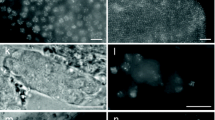Abstract
Organ- or tissue-specific ploidy level determination is often used for answering biological, molecular, genetic, or evolutionary questions in plant sciences. However, current techniques for ploidy determination either cannot provide information on single cell level, require destructive sample preparation, or are laborious and time-consuming. Here, we present a new approach developed in Arabidopsis thaliana, which is not only less labor intensive but also allows in vivo ploidy determination on single cell level. The technique is based on the incorporation of a transgenic construct, consisting of the centromere-specific protein CENH3 fused to the fluorescent reporter GFP that specifically labels centromeric regions and hence allows for an accurate visual determination of the cell’s chromosome number. Moreover, by combining the construct with a gametophyte-specific promoter, the technique enables accurate chromosome quantification in all individual gametophytic cell types formed during micro- and mega-gametogenesis. As such, CENH3-based centromere visualization provides an easy and straightforward method to monitor meiotic cell division integrity, gametophytic chromosome dynamics, and reproductive ploidy stability.
Access this chapter
Tax calculation will be finalised at checkout
Purchases are for personal use only
Similar content being viewed by others

References
Henry IM, Dilkes BP, Young K, Watson B, Wu H, Comai L et al (2005) Aneuploidy and genetic variation in the Arabidopsis thaliana triploid response. Genetics 170(4):1979–1988
Mursalimov S, Deineko E et al (2016) Cytomixis in tobacco microsporogenesis: are there any genome parts predisposed to migration? Protoplasma 254(3):1379–1384. doi:10.1007/s00709-016-1028-1
De Storme N, Geelen D et al (2011) The arabidopsis mutant jason produces unreduced first division restitution male gametes through a parallel/fused spindle mechanism in meiosis II. Plant Physiol 155(3):1403–1415
De Storme N, Copenhaver GP, Geelen D et al (2012) Production of diploid male gametes in arabidopsis by cold-induced destabilization of postmeiotic radial microtubule arrays. Plant Physiol 160(4):1808–1826
Ramsey J, Douglas W et al (1998) Pathways, mechanisms, and rates of polyploid formation in flowering plants. Annu Rev Ecol Evol Syst 29:467–501
Kotani Y, Henderson ST, Suzuki G, Johnson SD, Okada T, Siddons H, Mukai Y, Koltunow AM et al (2014) The LOSS OF APOMEIOSIS (LOA) locus in Hieracium praealtum can function independently of the associated large-scale repetitive chromosomal structure. New Phytol 201(3):973–981. doi:10.1111/nph.12574
Garmendia A, Ferriol M, Juarez J, Zając A, Kałużny K, Merle H et al (2015) A rare case of a natural contact zone in Morocco between an autopolyploid and an allopolyploid of Centaurea aspera with sterile tetraploid hybrids. Plant Biol 17(3):746–757. doi:10.1111/plb.12284
Ravi M, Shibata F, Ramahi JS, Nagaki K, Chen C, Murata M, Chan SW et al (2011) Meiosis-specific loading of the centromere-specific histone CENH3 in Arabidopsis thaliana. PLoS Genet 7(6):e1002121. doi:10.1371/journal.pgen.1002121
Dolezel J, Bartos J et al (2005) Plant DNA flow cytometry and estimation of nuclear genome size. Ann Bot 95(1):99–110
Dolezel J, Greilhuber J, Suda J et al (2007) Estimation of nuclear DNA content in plants using flow cytometry. Nat Protoc 2(9):2233–2244
Busch W, Herrmann RG, Houben A, Martin R et al (1996) Efficient preparation of plant metaphase spreads. Plant Mol Biol Rep 14(2):149–155
Jiang JM, Gill BS et al (2006) Current status and the future of fluorescence in situ hybridization (FISH) in plant genome research. Genome 49(9):1057–1068
Cleveland DW, Mao Y, Sullivan KF et al (2003) Centromeres and kinetochores: from epigenetics to mitotic checkpoint signaling. Cell 112(4):407–421
Miell MDD, Fuller CJ, Guse A et al (2013) CENP-A confers a reduction in height on octameric nucleosomes. Nat Struct Mol Biol 20(6):763–765. doi:10.1038/nsmb.2574
Zedek F, Veselý P, Horová L, Bureš P et al (2016) Flow cytometry may allow microscope-independent detection of holocentric chromosomes in plants. Sci Rep 6:27161. doi:10.1038/srep27161
De Storme N, Keçeli BN, Zamariola L, Angenon G, Geelen D et al (2016) CENH3-GFP: a visual marker for gametophytic and somatic ploidy determination in Arabidopsis thaliana. BMC Plant Biol 16(1). doi:10.1186/s12870-015-0700-5
Breuninger H, Rikirsch E, Hermann M, Ueda M, Laux T et al (2008) Differential expression of WOX genes mediates apical-basal axis formation in the Arabidopsis embryo. Dev Cell 14(6):867–876. doi:10.1016/j.devcel.2008.03.008
Engel ML, Holmes-Davis R, McCormick S et al (2005) Green sperm. Identification of male gamete promoters in arabidopsis. Plant Physiol 138(4):2124–2133. doi:10.1104/pp.104.054213
Smyth DR, Bowman JL, Meyerowitz EM et al (1990) Early flower development in Arabidopsis. Plant Cell 2(8):755–767
Lermontova I, Koroleva O, Rutten T, Fuchs J, Schubert V, Moraes I et al (2011) Knockdown of CENH3 in Arabidopsis reduces mitotic divisions and causes sterility by disturbed meiotic chromosome segregation. Plant J 68(1):40–50
Author information
Authors and Affiliations
Corresponding author
Editor information
Editors and Affiliations
Rights and permissions
Copyright information
© 2017 Springer Science+Business Media LLC
About this protocol
Cite this protocol
Keçeli, B.N., De Storme, N., Geelen, D. (2017). In Vivo Ploidy Determination of Arabidopsis thaliana Male and Female Gametophytes. In: Schmidt, A. (eds) Plant Germline Development. Methods in Molecular Biology, vol 1669. Humana Press, New York, NY. https://doi.org/10.1007/978-1-4939-7286-9_7
Download citation
DOI: https://doi.org/10.1007/978-1-4939-7286-9_7
Published:
Publisher Name: Humana Press, New York, NY
Print ISBN: 978-1-4939-7285-2
Online ISBN: 978-1-4939-7286-9
eBook Packages: Springer Protocols



